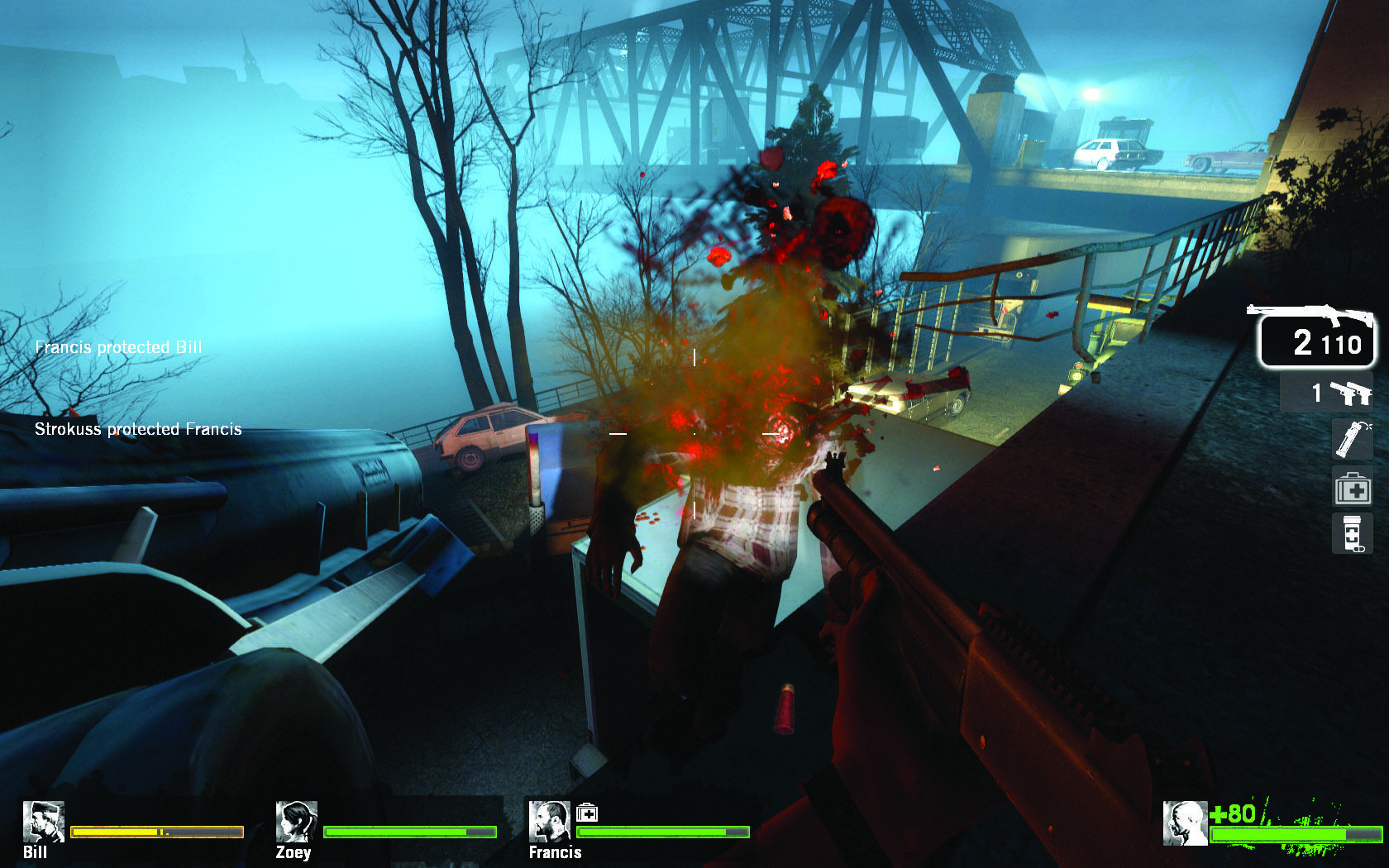12DOVE Verdict
Pros
- +
Incredibly tense gameplay
- +
Versus mode multiplayer
- +
Extremely replayable
Cons
- -
Only two versus campaigns
- -
No character customization
- -
No explicit story
Why you can trust 12DOVE
Rescue is here - after a long, bloody battle with countless zombies, you and three fellow survivors have made it to the rooftop of a ravaged hospital, where a helicopter lands to evacuate you to safety. In a blaze of gunfire and guts, you and two of your companions fight your way to the helipad and climb aboard the chopper, but the fourth member of your team is wounded and limping behind you. At the last second, a snake-like tongue shoots out from the darkness, wraps around him, and drags him kicking and screaming back into the grasp of the horde.
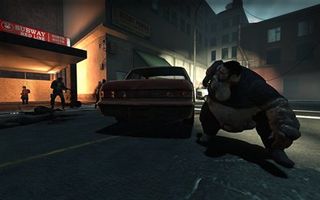
You have a choice to make: do you leave the chopper, endangering the lives of the rest of the team, to attempt a rescue? Or do you cut your losses, tell yourself you couldn’t have saved him, and try to ignore the horrible sounds of a swarm of flesh-hungry zombies tearing him limb from limb? The essence of gaming has often been described as “a series of interesting choices,” and this is easily one of the single most interesting choices I’ve ever faced.
Left 4 Dead is based on the same plot as those of nearly every zombie horror film ever made: as one of four survivors of a devastating zombie apocalypse, you must get from point A to point B in one piece in order to escape, but between you and your goal is an army of hungry zombies. L4D pays homage to its inspirational source material with movie poster-style loading screens and end-of-round stats that roll like credits. The four campaigns each average a little over an hour in length; they’re designed primarily to be played in co-op mode with three other players over Xbox Live, but you can play them all in single-player mode along with three AI-controlled survivors.
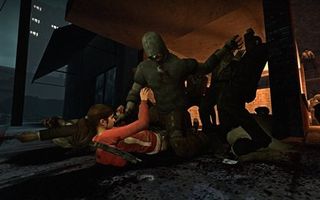
Each campaign begins with the four survivors in a “safe room” stocked with weapons, ammunition, and medical supplies, and equipped with a reinforced zombie-proof door (and a barred window that a zombie arm can reach through, groping around for a victim). The moment you unlock the door and step into zombie-infested territory is a good time to unlearn everything you know about playing squad-based shooters, because in L4D, to lose sight of your teammates is to invite doom.
The battle for survival is fast, bloody, and terrifying in a way so few “horror” games are. Swift-moving 28 Days Later-style zombies charge at you from everywhere and anywhere, attempting to grab a chunk of meat. L4D’s “Director” AI is remarkably effective at keeping you on your toes by spawning zombies in different, unexpected spots, giving you only a few moments to regroup between waves. The effect is seamless; while you will often be attacked by zombies coming from an area you’ve already swept clean, which makes no logical sense if you stop to think about it, there is little time for reality checks, and you’ll be too busy enjoying blasting zombie heads off to care, anyway.
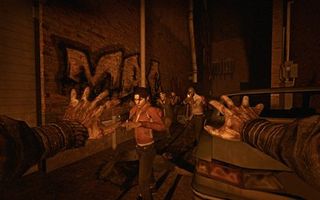
Maybe it’s because there haven’t been many good co-op-focused games up to this point, but this is the first time I have felt that I truly needed to act as part of the group in order to succeed. In most other team-based games (Counter-Strike being a notable exception), a “team” is a loose association of players who can run off and do their own thing if they want, and if they get killed, they just respawn and repeat. In L4D, respawning isn’t a right, it’s a privilege - get taken out and your teammates will have to find another survivor locked up in a closet (you, placed by the Director), or else you’re stuck in spectator mode until they reach the next safe room. Survivors are quite durable, though, and can be helped back up by a teammate even when their health is knocked down to zero a few times, so you don’t spend too much time in the penalty box.
The run-of-the-mill zombies are little more than backup dancers to the five types of “boss infected” that stalk you. Even in large numbers, normal zombies rarely pose a serious threat to well-coordinated survivors, but being forced to deal with the masses creates a perfect diversion that allows the boss infected to close in for the kill. It’s these super-zombies that truly put your survival in the hands of your teammates, because they can pin you down and render you helpless until a teammate comes to your rescue. While the existence of “special” zombies is somewhat antithetical to the entire concept of zombies, the variety and flavor they add to the action is undeniable, and they successfully prevent the inevitable boredom that comes from fighting just one type of enemy. Plus, hearing the disgusting gurgle of a Boomer or the distinctive, haunting wail of a Witch somewhere nearby elevates the tension to a level well above what is safely playable by gamers with heart conditions.
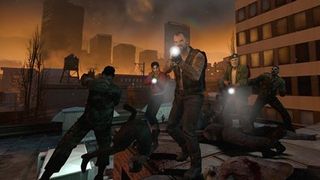
The importance of teamwork may be a point of frustration when playing online, at least at first. The ability to see your teammates’ outlines through walls is a more useful tool for coordination than any screen-cluttering mini-map, but trying to convince everyone to stick close and cover each other is tough even when you’re all experienced gamers sitting in the same room - doing it over the game’s built-in voice chat (or worse, the text-based quick-commands) with anonymous teammates accustomed to playing Rambo-style is a recipe for disaster. Your first few attempts are likely to end in tears, but once everyone has learned their very painful lesson and started to function as a group and listen to each other, the real game can begin.
Survivors are limited to one primary weapon - at the start of each campaign you have a choice of an Uzi or a pump-action shotgun - in addition to your unlimited-ammo backup pistol and a single pipe bomb or Molotov cocktail. In the later parts of the campaign you’ll be able to swap your primary weapon for a more powerful assault rifle, semi-automatic shotgun, or scoped hunting rifle. This is another means by which L4D forces cooperation, because one player cannot carry enough weaponry to handle every situation (and zombies will not let you call time-out to reload).

The current arsenal is a bit anemic, though, and boils down to only three types of weapon: rapid fire, shotgun, and long-range rifle - and the rifle is really only useful in certain wide-open areas where you can use the scope to snipe zombies. But, because the survivors are always on the move you can never hold a sniping position for very long, and the rifle’s low rate-of-fire makes it nearly useless in close-quarters combat indoors. It would have been nice to see some extra weapons (flamethrowers and chain saws come to mind), but there are enough available to get the job done.
No matter how good a shot you are, at least a few zombies will get up close and personal, and there are few things more terrifying than being surrounded by growling zombies tearing away at your flesh. Smacking them with your rifle-butt sends them staggering backwards for a second and gives you some breathing room - time to reload or retreat. But rifle-butting isn’t just a last resort - it’s also a very useful tool that can be used for a variety of tactics. For example, you can use it to push a Boomer back before shooting him, in order to avoid being slimed in the explosion.

Each campaign has a different setting, but all follow roughly the same structure, with five stages separated by safe rooms. It’s not all strictly run-and-gun as fast as you can towards the exit, though - Valve pulls a few tricks to mix up the pace. For example, at certain points you must push a button in order to clear a path - e.g., sending a van crashing through a locked door. Those situations come with a warning of, “Get ready to fight the horde!” This gives you a moment to dig in and think about how best to use your environment to destroy an incoming rush of zombies, such as setting up choke points and throwing down Molotov cocktails in their path, before triggering the rush.
Also, at random intervals determined by the director AI, the hulking Tank zombie will show up. It’s such a major event that the music changes to an ominous theme and the screen shakes, giving the survivors a brief warning that something really bad is about to go down, so they’d better change their tactics (like getting out of confined corridors and into an open area where they have a chance at evading, and everyone can get a clear shot). The director will also occasionally place a Witch in your path, making you change tactics once again by turning off your flashlights and sneaking by. Even though you get an audio warning in the form of her wailing cry, Witches can sometimes seem like unfair enemies, because if they spawn in certain positions, like right around a corner, it may be impossible to sneak by or even find them without startling them. That can easily ruin your good mood.
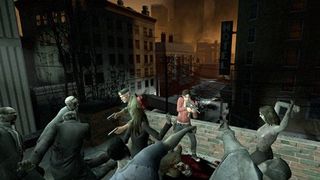
In the fifth stage of each campaign, the survivors reach a rendezvous point for their extraction and signal their readiness over a radio, then must hold out for several minutes against the most intense zombie onslaught yet. These climactic scenes are real nail-biters, with heavily armed survivors fending off attackers coming from all sides until rescue arrives, at which point they must make a desperate run for the evacuation vehicle against a last-minute zombie surge. It’s a scenario that all but the best players will only survive by the skin of their teeth, if at all, making for some incredibly tense moments.
The campaign content, which took our crack squad about six hours to fight through, may seem meager at first for a full-priced game, but once you’ve played it, try this trick: play it again. The Director ensures excellent variety on each playthrough by shuffling around weapon, item (like explosive barrels and ammo drops), and enemy placement. In one round, we set up an ambush for an incoming horde of zombies using a pair of gas cans we found, frying the entire lot nearly effortlessly. The next time through that same area there were no gas cans to be found, so we were forced to come up with a new strategy to deal with what we thought would be the same attack… but zombies poured through a vent in the ceiling behind us, taking us by surprise. Once you think you’ve got a handle on things, the advanced and expert difficulty levels will keep the challenge fresh for significantly longer (and unlock some extra achievements).

One relatively minor quibble that stuck in my craw is the inability to customize my in-game avatar. The four survivors (Bill, Louis, Zoey, and Francis) all look fantastic in this newest version of the Source engine, and sport detailed facial animations, plus individualized voices for contextual color commentary, but being shoehorned into one of these roles ever-so-slightly cramped my style. Plus, you don’t always get to choose which of the survivors to play as, and someone’s always going to get stuck playing as the girl. Not that there’s anything wrong with that, as the differences between characters are 100 percent cosmetic, but the lack of choice is a bit surprising in a modern game.
Besides lacking opportunities to barricade a door against a crowd of zombies or rip through them with a chain saw, and the notable absence of a shopping mall campaign (too cliche, Valve?), Left 4 Dead delivers every moment you could hope for in a zombie game. Case in point: you get to legitimately shout to your teammates, “Leave me, I’m done for! Save yourselves - GO!” while you try to buy them some time by firing your dual pistols into the descending horde as you lie wounded on the ground. And as awesome as that is, the unique experience of playing as the boss infected almost steals the show from the survivors. Left 4 Dead’s emphasis on teamwork and vague hints of story may not appeal to gamers who demand a focused single-player experience, but for the millions out there who have ever imagined their role in the inevitable Zombie Apocalypse, it simply cannot be missed.
Nov 17, 2008
More info
| Genre | Shooter |
| Description | An incredibly tense multiplayer experience like no other. A must buy for shooter fans. |
| Platform | "Xbox 360","PC" |
| US censor rating | "Mature","Mature" |
| UK censor rating | "18+","18+" |
| Alternative names | "Left For Dead" |
| Release date | 1 January 1970 (US), 1 January 1970 (UK) |
This slick Hades-style action roguelike with 92% positive reviews mysteriously vanished from Steam and the devs say they don't know why

Fallout creator Tim Cain reveals two playthroughs key to the RPG's history: his low-Int hero named Potato, and a mass-murderer who made them check "the entire game" again
Borderlands 4 studio Gearbox gave the devs custom cast iron skillets for Christmas because "we f***ing cooked"
